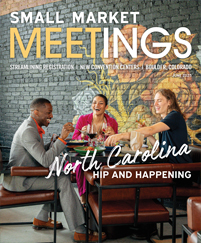More than ever, people are hungry for history. They want to know the story of a place and connect with a destination.
Planners can tap into that by booking historic meeting sites, which serve as both venues for events and experiences for attendees. In the history-rich Carolinas, organizers can reserve historic train stations, former firehouses, massive cotton mills, old cigar warehouses and even a famous artist’s summer retreat.
Historic Salisbury Station
Salisbury, North Carolina
The Salisbury Railway Passenger Station in Salisbury, North Carolina, opened in 1908 as a mainline stop between Washington, D.C., and Atlanta. At its height in 1911, up to 44 trains a day passed by the station, but after serving commuters for more than 70 years, it closed to passenger service in 1979.
In 1985, after the station had sat vacant for five years, the Historic Salisbury Foundation, a nonprofit that preserves the community’s historic buildings, bought it from the North Carolina Railroad Company. The group stabilized the building and made it weather-tight, then waited.
“We bought it to save it, and the intention was to turn around and sell it,” said Karen Hobson, Historic Salisbury Foundation executive director.
But nobody stepped forward with an acceptable plan to restore and reuse the depot, which received landmark status on the National Register of Historic Places in 1976.
“So we decided to raise money and restore it ourselves,” she said.
The foundation raised money and did the work in phases, investing about $3.1 million and reopening the station in 1993 as an event venue.
The Spanish Mission-style station has a classic facade and a central tower, stucco walls and a red-tile roof. Visitors enter through arched doors to the 3,440-square-foot Grand Waiting Room, where the original patterned ceramic floor is underfoot, and a barrel-vaulted ceiling and iron chandeliers are overhead. The central ticket booth can be used for registration and is often used as the bar, she said. To one side, two identical parlor rooms each offer 384 square feet for breakout space. On the other end of the hall is a catering kitchen and a boardroom.
Two sets of double doors open to the station’s other main function space: a sprawling, covered concourse where passengers once boarded trains. The 12,500-square-foot concourse is often used for cocktail hours or additional dinner seating, and because it’s already covered, “it gives some flexibility to use the outdoor space.”












